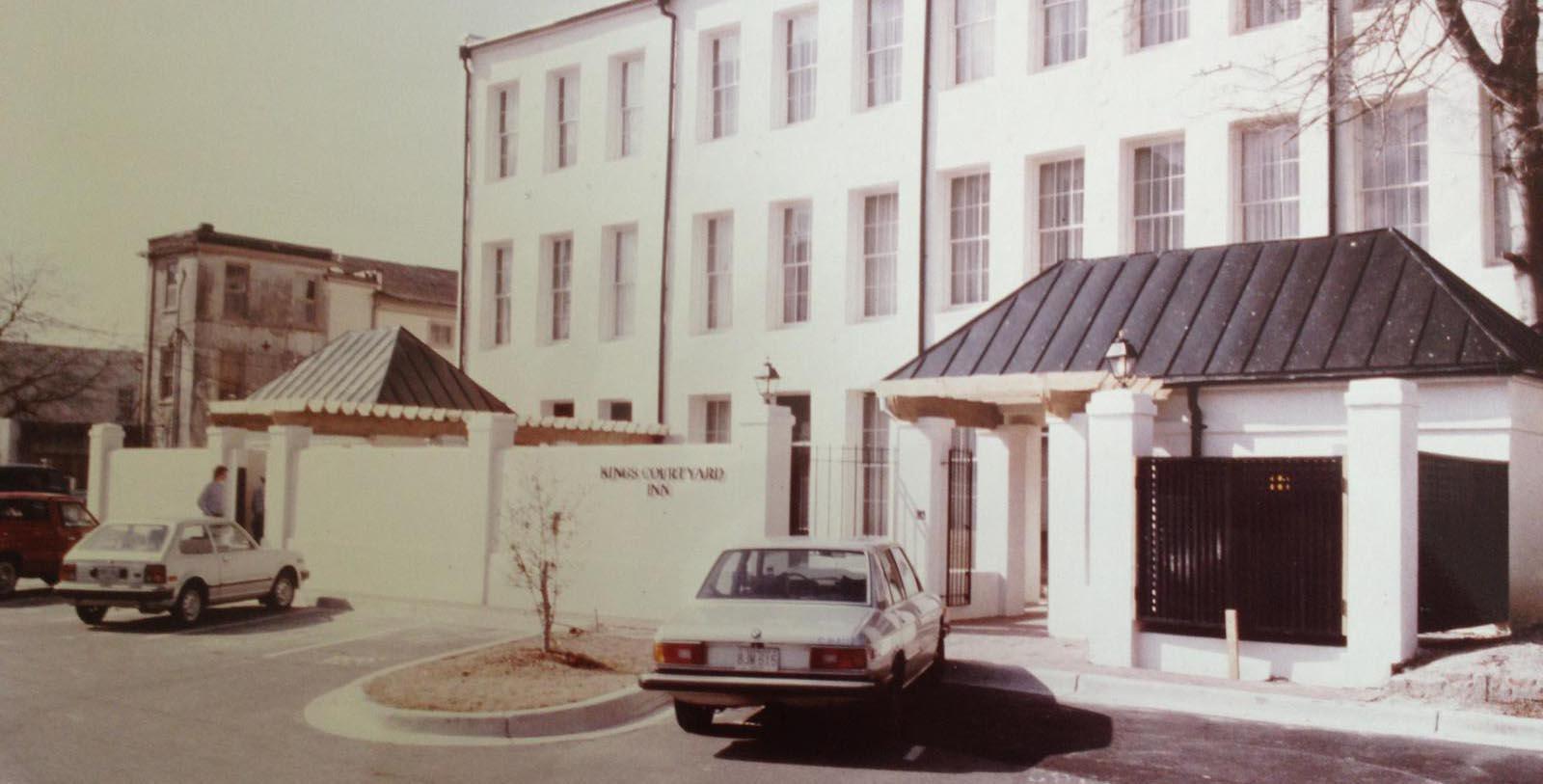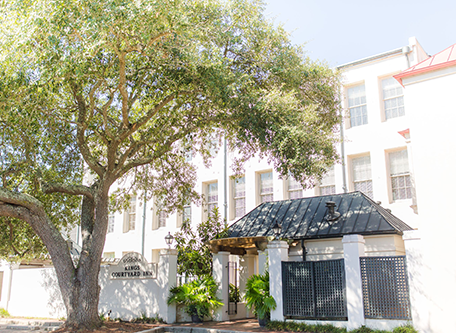Receive for Free - Discover & Explore eNewsletter monthly with advance notice of special offers, packages, and insider savings from 10% - 30% off Best Available Rates at selected hotels.
history
Discover Kings Courtyard Inn in the heart of the Charleston Historic District, which is a U.S. National Historic Landmark.
Kings Courtyard Inn, a charter member of Historic Hotels of America since 1989, dates back to 1853.
VIEW TIMELINEThe Kings Courtyard Inn has stood as a cherished local icon along King Street, one of the most historic thoroughfares to pass through Charleston. Indeed, King Street was the second road that the city’s founders created back during the 1600s, which they christened in honor of the reigning king of England at the time, Charles II. For generations, King Street was part of Charleston’s vibrant economy, hosting all kinds of upscale storefronts, banks, and offices spaces. By the beginning of the 19th century, King Street possessed an amazing array of ornately crafted retail spaces rarely seen elsewhere in the South. It was within this environment that Colonel J. Charles Blum created what would become the future Kings Courtyard Inn. Colonel Blum specifically desired to get involved within King Street’s marketplace, prompting the officer to construct a stunning three-story mixed-use commercial structure. As such, the colonel hired a renowned Charleston-based architect named Francis D. Lee to design the new building, who subsequently used a combination of ancient Egyptian and Greek motifs to craft its appearance. (The Greek Revival architecture was the more prominent of the two styles used.) Construction began in the early 1850s and took several months to complete. And when the project finally ended in 1853, it was truly a sight to behold.
Known as the “Blum Building,” the structure went on the house a number of businesses over the next few years. A couple shops specifically opened throughout the first floor, while a tavern operated out of the upper levels. Nevertheless, the Blum Building—as well as the rest of King Street—fell into considerable decline in the wake of the American Civil War. The war's devastating effect on the Southern economy changed the character of the stores active inside the building. As such, the commercial spaces within the Blum Building changed considerably over the next century, housing enterprises like a Singer Sewing Machine, a Salvation Army for lodging women, a dry cleaner, and even a skating rink. Thankfully, in 1983, a comprehensive renovation fully restored the building back to its former glory. The work touched upon every aspect of its layout, which transformed the building into a wonderful boutique hotel known as the “Kings Courtyard Inn.” The architects even installed two courtyards within the center of the building by uncovering and enlarging two of its original light wells. The historic structure then became a founding member of Historic Hotels of America alongside 34 other charter members five years later. The Kings Courtyard Inn has since continued to serve as one of the best holiday destinations in downtown Charleston. Part of a National Historic Landmark District today, its period guestrooms and fantastic courtyards still enchant all who step inside.
-
About the Location +
Named after King Charles II of England, Charleston is among the most historic cities in the whole United States. The first settlers to found the city arrived back in the mid-17th century, when the Lords Proprietors—the original officers for the unsettled Carolina territory—began moving colonists from Barbados and Bermuda to the area. Intent on creating a town as quickly as possible, the Lords Proprietors selected a number of sites around the confluence of the Ashley and Cooper rivers, before finally finding success at a place called “Oyster Point” in 1672. Despite intending to develop the settlement around a visionary plan known as the “Grand Model,” “Charles Towne”—as it was called then—was never incorporated until the American Revolution had ended. Instead, city officials passed local ordinances in the form of municipal laws that attempted to give some kind of legitimacy to the nascent community. Nevertheless, life in early Charleston was incredibly tough, as the town was beset by hostile groups of French, Spanish, and Native American armies. Pirates posed a serious problem, too, who raided the coastline frequently. In fact, Edward Teach—remembered today as “Blackbeard”—was among the pirates to harass Charleston regularly at the time. Furthermore, malaria and other tropical diseases took their toll on the English colonists, as did natural weather phenomenon like hurricanes.
Growth only picked up once immigrant populations from Europe began expanding westward into the South Carolina interior. Their arrival also saw the city’s economic fortunes change significantly, as it rapidly emerged as a commercial port for the outlying farms that surrounded Charleston. Rice, indigo, and other cash crops were common exports transported into Charleston’s natural harbor, which helped make the city one of the most prosperous in the Thirteen Colonies. But the new maritime commerce had a considerable dark side, for the transatlantic slave trade had also played a role in Charleston’s rebirth. By the eve of the American Revolution, nearly half of the city’s population—some 11,000 people—were either enslaved Africans or their descendants. Still, Charleston’s size and prosperity as a port made it one of the largest cities in British America, as well as the principal point of entry for any person—free or enslaved—entering into the South.
Charleston remained a busy port even as Great Britain continuously targeted the city throughout the American Revolutionary War. The city itself was eventually captured after British general Sir Henry Clinton successfully subjected it to a prolonged siege in 1780. Still, even greater economic prosperity awaited Charleston once Eli Whitney’s cotton gin made the cultivation of cotton an incredibly lucrative endeavor for local planters. Cotton soon became the primary staple crop shipped through Charleston Harbor right up to mid-19th century. But the number of slaves transported into the city increased dramatically, too. The local devotion to slavery made the city’s white residents committed to the concept of southern secession—an idea that became reality when South Carolina’s state legislature voted to secede following Abraham Lincoln’s first election in 1860. Charleston soon found itself at the middle of the American Civil War that followed, with the first shots of the conflict fired right within its own borders. Rebel militia under the command of P.G.T. Beauregard specifically bombarded the U.S. Army-occupied Fort Sumter shortly after Lincoln’s call for volunteers in April 1861. Four years of constant warfare came in the wake of the attack, which eventually destroyed much of Charleston and the rest of South Carolina.
Charleston struggled to emerge from the conflict, as industrialists and other entrepreneurs chose to move their operations elsewhere. But in the early 20th century, Charleston underwent a significant cultural renaissance that sought to highlight the positive aspects of the city’s history and culture. New art and literature appeared throughout Charleston, while many historic structures were preserved for the first time. Race relations also began to improve, with local African Americans gradually gaining access to more rights and liberties by mid-century. Charleston now rates among America’s most diverse communities, as well as one of its most culturally vibrant. People today love traveling to the city to experience its many interesting historic sites, such as Fort Sumter, the Historic Charleston City Market, and Magnolia Plantation and Gardens. But visitors also adore the wealth of historical architecture that calls Charleston home, giving it an incredibly gorgeous landscape. Many of those aesthetics—ranging from Greek Revival to Federal—reside within famous neighborhoods like the renowned Charleston Historic District. The Charleston Historic District was even designated a U.S. National Landmark by the U.S. Secretary of the Interior in 1966!
-
About the Architecture +
The Kings Courtyard Inn stands as a brilliant example of Greek Revival architecture, one of the most common historical styles in the southern United States. Greek Revival style architecture first appeared throughout the western world during the late 18th and early 19th century. It appeared at a time when intellectuals in both Europe and English-speaking North America became obsessed with Greco-Roman culture. The style borrowed heavily from elements of Greek architecture, using it to build a wide variety of civic facilities. Ancient Greek culture was especially popular, for most people knew little about its history. The first archeological excavations had occurred earlier in the 18th century, exposing Hellenistic Greece to the West en mass for the first time. But while many European architects utilized the Greek Revival-style architecture, it truly reached the pinnacle of its popularity in the United States. In fact, some historians consider Greek Revival-style to be the nation’s very first “national” architectural form! The reason for that steeped interest was drawn from romanticized interpretations of Greek society that had started to permeate throughout America. The United States was a young nation at the end of the 1700s, and its citizens were desperate for previous democratic examples that they could emulate in their won republic. Nowhere was this desire more apparent than among the country’s founding elite. They looked to the philosophies of the Grecian republics of antiquity for successfully examples of popular government. This pursuit gradually seeped into the cultural fabric of the United States, influencing everything from artwork to literature. Even the names of several towns—including Ithaca, New York, and Athens, Georgia—reflected this development.
The national fascination with ancient Greece took root in America’s architectural practices, too. Many architects began designing buildings that mimicked structures like the great the Parthenon. Even Thomas Jefferson—known to be an accomplished engineer—used Greek design principles to create the Virginia State Capitol Building in 1785. American architects—as well as their European counterparts—typically constructed buildings in the style of Greek Revival by using a symmetrical foundation anchored by combination of stucco and wooden walls. They subsequently painted them white to give the illusion that they had been constructed out of marble or some other elegant stone. A brilliant front portico acted as the main entrance into the building, which was surrounded by a large porch that could span the length of the building’s front façade. The roof itself was low pitched and was either gabled or hipped. Just below the rooftop rested an area called the “entablature” that consisted of elaborate trimming and cornicing. In some cases, the entablature itself consisted of a frieze where most of the decorative work resided. But perhaps the single greatest defining feature of Greek Revival-style buildings were the many columns (or pilasters) that proliferated throughout the interior and exterior. Architects designed the columns in one of three sub-categorical styles known as Doric, Ionic, and Corinthian. They were also usually fluted or smooth and featured an ornate structure called a “capital” at the top. By the 1820s, Greek Revival-style architecture had become the most widely used in the United States. It remained that way for the next three decades, until different revivalist architectural forms finally displaced it in popularity.

































